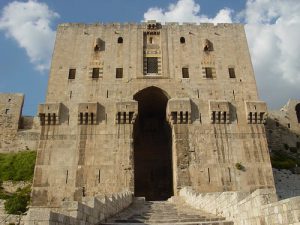 Archaeologist and historian Ross Burns knows Syria better than most, having lived there (and in Lebanon) for many years. He is the author of The Monuments of Syria: A Guide and Damascus: A History.
Archaeologist and historian Ross Burns knows Syria better than most, having lived there (and in Lebanon) for many years. He is the author of The Monuments of Syria: A Guide and Damascus: A History.
Ross, who is currently preparing a doctorate on the archaeology of the Roman provinces of the Eastern Empire, has lectured at a range of institutions in Australia. He also leads study tours to Syria and Jordan for British and Australian travel companies.
He explains why narrowing Syria’s ancient treasures down to a top 10 proves such a challenge:
It’s not difficult to guess which of the hundreds of wonderful sites in Syria, of which around 130 are recorded in The Monuments of Syria, should be my favourites. I give the sites in the guide ‘star ratings’ – one to three stars based on what you should include in a visit according to the amount of time available. There are nine three star sites – Aleppo, Apamea, Bosra, Damascus, the Krak des Chevaliers, Palmyra, the Castle of Marqab, the Castle of Saladin and the Church of St Simeon.
The Top 2

Visual impact is a big factor in the choice but I also wanted to give a sample that represented the immense variety of Syria’s remains and the many cultures that have made up its mosaic. Aleppo and Damascus are there because they are two of the oldest inhabited urban centres still surviving.
Damascus has an unchallenged claim when you add the word ‘capital’ since it has been the centre of several world or regional empires and remains the capital of Syria.
Both cities, though, have rich and complex pasts that are reflected in the enormous range of monuments, particularly from the Arab and Islamic centuries. Such stunning sites as the Great Mosque of the Umayyads in Damascus or the Citadel of Aleppo in themselves make a trip to Syria worthwhile.
3: Church Of St Simeon

Just to the west of Aleppo lies the complex of the Church of St Simeon, virtually intact to its roofline. Four immense basilicas cluster around a central courtyard which contains the remains of the column on top of which the fifth century Christian monk, Simon the Stylite, spent the last few decades of his life.
4, 5, & 6: The Castle At Marqab, the Castle of Saladin and Krak des Chevaliers
Three sites represent the period of the Crusades and the Muslim resistance to it – the castle at Marqab looming over the thin coastal route that joined the Crusaders to their homelands in Europe; the Castle of Saladin positioned along a ridge looking down to the distant Mediterranean; and the greatest of all Crusader castles anywhere, the massive and largely intact Krak des Chevaliers.
7, 8 & 9: Apamea, Bosra and Palmyra
Apamea, Bosra and Palmyra are some of the best-preserved cities of the Classical period found around the Mediterranean. Palmyra certainly deserves the label of ‘Caravan City’ and the picture its surviving colonnades and the Temple of Bel present set against a seemingly hostile wilderness makes an extraordinary impression.
Bosra also preserves – alongside its Roman-era remains, including the best-preserved theatre of the Roman world –
much evidence of its importance in the Arab centuries including the striking fortress that wraps around the ancient theatre. Apamea, another impressive classical city, presents the extraordinary site of its 2km-long central axis lined with columns striding across the rich pastureland on the edge of the Orontes Valley.
And Number 10…
OK, so what’s my tenth site? Well, the trouble I have in Syria is it’s easy enough to pick the knock-out places. It’s the ones that are only a shade below knock-out – but that you might visit at the right time of year or at the right time of day, with the right guide or with a great collection of friends – that are hard to pick between. Some of the sites along the Euphrates clamber for attention for those with the time – the Bronze Age site at Mari, the extensive fortress at Dura Europos (still surviving much as on the fateful day when the Roman forces lost it to the Sasanians in the 250s AD), the Byzantine fortresses at Resafa and Halebiye. Forced to choose, I have to admit I make a different selection each time, but I have a particular weak spot for the extraordinary trangular fortification at Halebiye, built by Justinian in the sixth century in a white gypsum stone that sparkles just wonderfully at sunset as it tumbles down the slopes to the Euphrates River.
So, there! I’ve committed myself to a tenth – for the moment. If you ask me tomorrow I might have a different story. The problem with Syria is that there are so many wonderful sites and experiences spread across millennia that a person would be foolhardy to say that one or 10 or 100 were the best. It’s the whole experience that matters. Go see for yourself.
